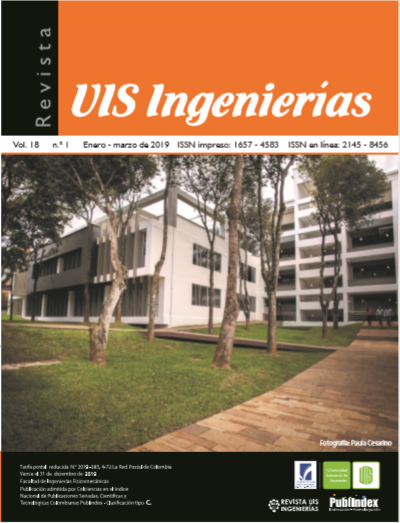Desarrollo de una herramienta de corte de flores, mediante requerimientos ergonómicos de diseño
Publicado 2019-01-01
Palabras clave
- fuerza en los dedos,
- gesto de aprehensión,
- herramienta de corte,
- síndrome del túnel carpiano
Cómo citar
Resumen
La fuerza de la mano y la postura de la muñeca son los factores de riesgo para el desarrollo del síndrome del túnel carpiano, y las tasas más altas de esta patología las presenta el sector floricultor colombiano. Este estudio tiene como objetivo el desarrollo y la validación de una herramienta manual de corte de flores, que permita mantener el diámetro de aprehensión, mejorando la ventaja mecánica y mitigando el factor de fuerza. Esto se desarrolló en dos fases: primera, la propuesta de un modelo funcional de la herramienta de corte, y, segunda, su validación en laboratorio. Se encontró que el tipo de herramienta tiene asociación con la fuerza de los dedos y que la herramienta propuesta presenta el menor valor de fuerza necesaria para realizar el corte. Se concluye que es necesario desarrollar las herramientas con requerimientos de la población colombiana para mitigar enfermedades ocupacionales que puedan dejar lesiones de por vida a los trabajadores.
Descargas
Referencias
"Annual Sustainability Report,” Asociación Colombiana de Exportadores de Flores ASOCOLFLORES, Colombia, 2014.
M. González Reyes, P.Fonte and E. González, “Las mujeres en la industria Colombiana de las flores,” Corporación Cactus, Asociación Paz con Dignidad, 2014.
L. H. Barrero et al., “Physical workloads of the upper-extremity among workers of the Colombian flower industry,” Am. J. Ind. Med., vol. 55, no. 10, pp. 926–939, 2012. doi: 10.1002/ajim.22102
V. H. Hildebrandt, “Musculoskeletal symptoms and workload in 12 branches of Dutch agriculture,” Ergonomics, vol. 38, no. 12, pp. 2576–2587, 1995. doi: 10.1080/00140139508925287
J. Breilh., “Cut Flowers Production Impact on Life and Health in the Andean Middle of the World,” in International Code Of Conduct For The Production Of Cut Flowers North – South Seminar, Germany & Holland, 2001, pp. 1-10.
L. Quintana., L. Saavedra., “Análisis dinamométrico en herramientas de corte de rosas,” in VIII Congreso Internacional de Prevención de Riesgos Laborales, Valencia, España, 2010.
K.C. Reyes., E.A. Valero., “El lado oscuro en las prácticas de responsabilidad social corporativa del sector floricultor," Revista Innovar, vol. 16, no. 27, pp. 73-90, 2006.
M. R. Salgado., K. Camacho, “La Globalización contrariada. Trabajo, territorio y dominación en la floricultura de la sabana de Bogotá,” Revista Colombiana de Sociología, no. 27, pp. 127-149, 2006.
R. G. García-Cáceres, S. Felknor, J. E. Córdoba, J. P. Caballero, y L. H. Barrero, “Hand anthropometry of the Colombian floriculture workers of the Bogota plateau”, Int. J. Ind. Ergon., vol. 42, no. 2, pp. 183–198, 2012. doi: 10.1016/j.ergon.2011.12.002
W. G. Lewis y C. V. Narayan, “Design and sizing of ergonomic handles for hand tools,” Appl. Ergon., vol. 24, no. 5, pp. 351–356, oct. 1993. doi: 10.1016/0003-6870(93)90074-J
J.C. Aristizábal, “La enfermedad laboral en Colombia,” Fasecolda, [Online]. Available: http://www.fasecolda.com/files/2214/4909/2246/Aristizabal._2013._La_enfermedad_laboral_en_Colombia.pdf
O. Páez, “La realidad bajo los invernaderos, Informe de Floricultura,” Corporación Cactus, 2011 [Online]. Available: http://www.cactus.org.co/archivos/documentos/Publicaciones/informe/Informe%20de%20Floricultura%20Mayo%202011.pdf.
G.A. Castillo., "Diseño y desarrollo de una herramienta manual para corte de tallos maderosos en la industria floricultora de la sabana de Bogotá," Revista Sennova, vol. 1, no. 1, pp. 107-124, 2014.
F. Espinel., Z. Galindo., F. Maradei., "Apertura de la herramienta manual y fuerza de aprehensión durante el corte de flores," Arch Prev Riesgos Labor, vol. 17, no. 4, pp. 190-195, 2014. doi: 10.12961/aprl.2014.17.4.03
“Dirección económica y logística,” ASOCOLFLORES, 2015 [Online]. Available: http://asocolflores.org/aym_images/files/CENTRO_DE_DOCUMENTACION/ECONOMIA%20Y%20LOGISTICA/BOLETINES%20ESTADISTICOS/Boletin%20Estadistico%202014%20Asocolflores.pdf
D. Chaffin., L. Greenberg, Workers and their tools: A guide to the ergonomic design of handtools and small presses. Midland, Michigan, USA: Pendall Publishing, 1977.
L. Quintana., L. Saavedra., “Análisis dinamométrico en herramientas de corte de rosas,” VIII Occupational Risk Prevention ORP, Valencia, 2010.
“Las dimensiones de la mano. Factores humanos para el desarrollo de productos,” Instituto de Biomecánica de Valencia (IBV), Valencia, 2010.
J. Rodriguez., F. Maradei, J. Martinez., “Mechanical advantage for manual cutting in floriculture activity,” in Ergonomía Ocupacional, Investigaciones y Aplicaciones, Tijuana, 2016, vol. 9, pp. 67-70.

